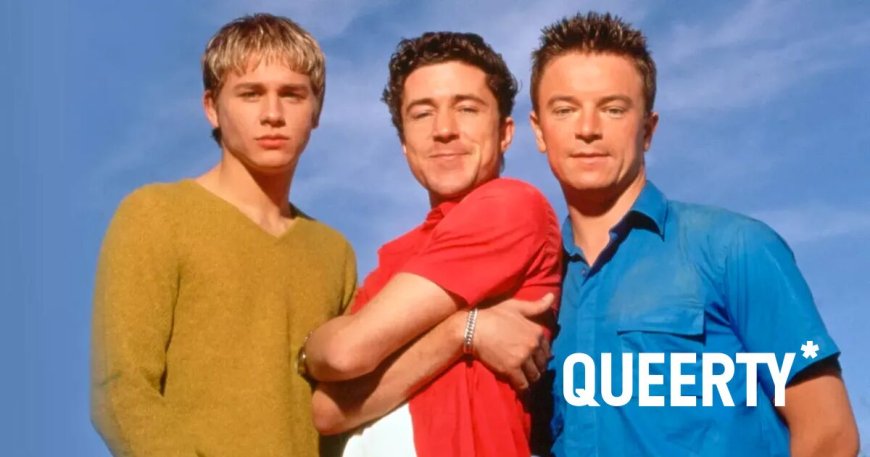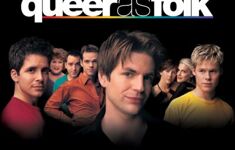25 years ago, ‘Queer As Folk’ debuted with a provocative (& problematic) premiere
While it courted plenty of controversy, the groundbreaking 'Queer As Folk' was proof that we weren't alone.


Twenty-five years ago today, the original Queer As Folk premiered on the British network Channel 4, fearlessly breaking down barriers for LGBTQ+ representation on television.
Created by prolific TV producer Russell T Davies (It’s A Sin, Doctor Who), Queer As Folk—which inspired an equally influential American version the following year—dared to depict modern gay life in all its messy glory, specifically following the interconnected lives of three men living in and around Manchester’s historic gay village.
Sure, Ellen Degeneres had already come out via her eponymous sitcom, and Will & Grace was in the middle of its groundbreaking first season, but Davies’ series was something else entirely. Up until that point, LGBTQ+ characters were often kept on the sidelines, or introduced for a “very special episode” to teach a lesson or bring about some shocking twist in a gambit to spike viewership.
Your daily dose of fabulousi-TEA
Subscribe to our daily newsletter for your front-row seat to all things entertainment with a sprinkle of everything else queer.
But Queer As Folk was a show for us, by us, unafraid of what “mainstream” audiences might think. It was bold, sexually explicit, and unapologetically queer. When the series premiered on February 23, 1999, there was nothing quite like it, and all these years later, it still feels fresh, daring, and provocative—for better and for worse.
The pilot episode, titled “Thursday,” welcomes viewers to the Canal Street gay bar Babylon, full of life on a Thursday night. We meet longtime friends Stuart (Game Of Thrones‘ Aidan Gillen), a successful ad exec alpha gay, and Vince (Coronation Street‘s Craig Kelly), a supermarket manager who’s still closeted at work, both out on the prowl and looking for someone to take home.
Before long, Stuart encounters the twinky Nathan (a young Charlie Hunnam, well before his Sons Of Anarchy days)—and this is where the show’s problems begins. Nathan is a high-schooler, just 15 years old. The 29-year-old Stuart doesn’t know it at first, but when he does find out the truth, it doesn’t exactly deter him. 
In fact, the two engage in sex multiple times throughout the episode, before and after the revelation, including a scene where Stuart teaches Nathan the joys of rimming (a scene no doubt etched in the memories of anyone watching the show when it first aired).
Related:
7 surprising and somewhat problematic observations I made rewatching Season 1 of ‘Queer As Folk’
Whether you watched the show chronologically when it first aired in the early 2000s or unapologetically recorded episodes on your parent’s TiVo as a closeted teenager like me, Showtime’s “Queer as Folk” was a major milestone in LGBTQ entertainment.
Ironically, the age gap seemed to be the least of audiences’ concerns when the show first premiered. Conservatives, of course, were aghast at just how explicit Queer As Folk was, showing plenty of male nudity and simulated sex acts—including that moment of anilingus.
But gay audiences were upset, too, criticizing the series for its failure to address or even acknowledge the AIDS epidemic. In response, Davies said that his show was meant to be a celebration of gay life, radically choosing to focus on love and joy in the face of so much death, sadness, and hatred.
While those complaints are easier to look past in retrospect, 25 years on, it’s still hard to reconcile with the relationship between Stuart and Nathan, which remains a narrative thread throughout the series. More recently, Davies has acknowledged why it’s problematic, but seems to stand by it as an honest depiction of life’s complexities:
“They said, ‘that’s illegal,'” he recalled to The New Statesman, reflecting on the show’s pushback. “You can show bank robberies, you can show murders. Television’s about an awful lot of illegal stuff… if Queer As Folk was new now, I’d be having to defend that a lot harder.”
(Notably, in the American remake, Nathan’s counterpart, Justin (Randy Harrison), is aged up to 17, and over the course of its five-season run, is given much more agency in their relationship.)
Related:
Russell T. Davies has left an undeniable mark on queer television and he’s not finished yet
Davies has earned a reputation as one of the great, living queer storytellers, having enjoyed huge success with his shows “Queer as Folk,” “A Very English Scandal,” and “It’s A Sin.”
Of course, our media isn’t beholden to such black-and-white moralities—we’ve watched and celebrated television that follows the stories of all sorts of complicated anti-heroes. And even Queer As Folk knows Stuart isn’t perfect, showing him to be overtly cocky and self-interested. Still, it can be hard to stomach its often plucky and playful approach to the Nathan relationship.
Hopefully, 25 years on, we can acknowledge these faults while holding space to appreciate what Queer As Folk has meant to queer audiences. For some, it was a chance to see ourselves, our world on screen—in all of its beautiful, messy glory. For other, younger viewers (who maybe felt they had to watch in secret), it was a glimpse at a possible future, providing hope that there was a place, a community where we could belong.
But no matter your age, Queer As Folk was a crucial reminder that we weren’t alone. These were folks—queer folks—just like us.
Scroll down below for some Queer As Folk 25th anniversary celebrations from Gay Twitter :
:

 Mark
Mark 







